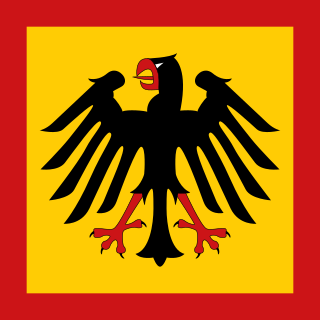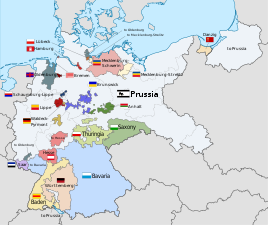
The president of Germany, officially titled the Federal President of the Federal Republic of Germany, is the head of state of Germany.

The Reichstag Fire Decree is the common name of the Decree of the Reich President for the Protection of People and State issued by German President Paul von Hindenburg on the advice of Chancellor Adolf Hitler on 28 February 1933 in immediate response to the Reichstag fire. The decree nullified many of the key civil liberties of German citizens. With the Nazis in powerful positions in the German government, the decree was used as the legal basis for the imprisonment of anyone considered to be opponents of the Nazis, and to suppress publications not considered "friendly" to the Nazi cause. The decree is considered by historians as one of the key steps in the establishment of a one-party Nazi state in Germany.

The Enabling Act of 1933, officially titled Gesetz zur Behebung der Not von Volk und Reich, was a law that gave the German Cabinet – most importantly, the Chancellor – the power to make and enforce laws without the involvement of the Reichstag or Weimar President Paul von Hindenburg, leading to the rise of Nazi Germany. Critically, the Enabling Act allowed the Chancellor to bypass the system of checks and balances in the government.

The German Bundesrat is a legislative body that represents the sixteen Länder of Germany at the federal level. The Bundesrat meets at the former Prussian House of Lords in Berlin. Its second seat is located in the former West German capital of Bonn.

The North German Confederation was initially a German military alliance established in August 1866 under the leadership of the Kingdom of Prussia, which was transformed in the subsequent year into a confederated state that existed from July 1867 to December 1870. A milestone of the German Unification, it was the earliest continual legal predecessor of the modern German nation-state known today as the Federal Republic of Germany.

The Constitution of the German Reich, usually known as the Weimar Constitution, was the constitution that governed Germany during the Weimar Republic era (1919–1933). The constitution declared Germany to be a democratic parliamentary republic with a legislature elected under proportional representation. Universal suffrage was established, with a minimum voting age of 20. The constitution technically remained in effect throughout the Nazi era from 1933 to 1945 as well as during the Allied occupation of Germany from 1945 to 1949, though practically it had been repealed by the Enabling Act of 1933 and thus its various provisions and protections went unenforced for the duration of Nazi rule, and after World War II, the power of the Allied Control Council and four occupying powers once again stood above the provisions of the constitution.

Wilhelm Marx was a German judge, politician and member of the Catholic Centre Party. During the Weimar Republic he was the chancellor of Germany twice, from 1923–1925 and 1926–1928, and served briefly as the minister president of Prussia in 1925. With a total of 3 years and 73 days, he was the longest-serving chancellor during the Weimar Republic.

The Constitution of the German Empire was the basic law of the German Empire of 1871–1918, from 16 April 1871, coming into effect on 4 May 1871. German historians often refer to it as Bismarck's imperial constitution, in German the Bismarcksche Reichsverfassung (BRV).

The Free State of Prussia was one of the constituent States within the Weimar Republic from 1918 to 1947. As the successor of the Kingdom of Prussia, the Weimar Republic maintained Prussia as its dominant state despite the significant post-war territorial losses imposed by the Treaty of Versailles. Prussia was home to the federal capital Berlin, which comprised 62% of the territory and where 61% of the population resided. It transitioned from the authoritarian state it had been in the past to a parliamentary democracy under the Prussian Constitution of 1920. During the Weimar Republic, it was governed almost entirely by pro-democratic parties, proving to be more politically stable than the Republic itself. With brief interruptions, the Social Democratic Party (SPD) provided Prussia's first Minister President, Paul Hirsch. In the following years, interior ministers from the SPD promoted republican reforms in government administration and police procedures, establishing Prussia as a bulwark of democracy within the Weimar Republic.

The Weimar National Assembly, officially the German National Constitutional Assembly, was the popularly elected constitutional convention and de facto parliament of Germany from 6 February 1919 to 21 May 1920. As part of its duties as the interim government, it debated and reluctantly approved the Treaty of Versailles that codified the peace terms between Germany and the victorious Allies of World War I. The Assembly drew up and approved the Weimar Constitution that was in force from 1919 to 1933. With its work completed, the National Assembly was dissolved on 21 May 1920. Following the election of 6 June 1920, the new Reichstag met for the first time on 24 June 1920, taking the place of the Assembly.

The chancellor of Germany, officially the federal chancellor of the Federal Republic of Germany, is the head of the federal government of Germany, and the commander-in-chief of the German Armed Forces during wartime. The chancellor is the chief executive of the Federal Cabinet and heads the executive branch. The chancellor is elected by the Bundestag on the proposal of the federal president and without debate.

The States of the Weimar Republic were the first-level administrative divisions and constituent states of the German Reich during the Weimar Republic era. The states were established in 1918 following the German Revolution upon the conclusion of World War I, and based on the 22 constituent states of the German Empire that abolished their local monarchies. The new states continued as republics alongside the three pre-existing republican city-states within the new Weimar Republic, adopting the titles Freistaat or Volksstaat.

The Reichstag of the German Empire was Germany's lower House of Parliament from 1871 to 1918. Within the governmental structure of the Reich, it represented the national and democratic element alongside the federalism of the Bundesrat and the monarchic and bureaucratic element of the executive, embodied in the Reich chancellor. Together with the Bundesrat, the Reichstag had legislative power and shared in decision-making on the budget. It also had certain rights of control over the executive branch and could engage the public through its debates. The emperor had little political power, and over time the position of the Reichstag strengthened with respect to both the imperial government and the Bundesrat.

The Reichstag of the Weimar Republic (1919–1933) was the lower house of Germany's parliament; the upper house was the Reichsrat, which represented the states. The Reichstag convened for the first time on 24 June 1920, taking over from the Weimar National Assembly, which had served as an interim parliament following the collapse of the German Empire in November 1918.

The Prussian State Council was the second chamber of the bicameral legislature of the Free State of Prussia between 1921 and 1933; the first chamber was the Prussian Landtag. The members of the State Council were elected by the provincial parliaments and gave the provinces of Prussia a voice in the legislative process. The Council had an indirect right to introduce legislation, could object to bills passed by the Reichstag and had to approve expenditures that exceeded the budget.

The Bundesrat was the highest legislative body in the German Empire (1871–1918). Its members were appointed by the governments of Germany's constituent states to represent their interests in the German parliament. The popularly elected Reichstag was the lower house. The Constitution of the German Empire required that both the Bundesrat and the Reichstag approve laws before they came into force. The Bundesrat was responsible for the enactment of the laws, administrative regulations and the judicial resolution of disputes between constituent states. Its approval was required for declarations of war and, with certain limitations, the conclusion of state treaties.
The Provisional Law and Second Law on the Coordination of the States with the Reich were two laws enacted by the German government of Adolf Hitler to expand its control over the seventeen German states (länder). The Provisional (First) Law dissolved all the sitting landtage, except for that of Prussia, and reconstituted them in accordance with the results of the recent parliamentary election of 5 March 1933, which had given the Nazi Party and its coalition partner, the German National People's Party (DNVP), a majority of the Reichstag seats. The Second Law established the new powerful position of Reichsstatthalter appointed by the central government to effectively take control of each state administration. The effect of these laws was to undermine the power and influence of all political parties other than the Nazis and the DNVP, and to move Germany significantly away from being a federal republic and put it on a path to becoming a unitary state.

The German constitutional reforms of October 1918 consisted of several constitutional and legislative changes that transformed the German Empire into a parliamentary monarchy for a brief period at the end of the First World War. The reforms, which took effect on 28 October 1918, made the office of chancellor dependent on the confidence of the Reichstag rather than that of the German emperor and required the consent of both the Reichstag and the Bundesrat for declarations of war and for peace agreements.
The Law on the Reconstruction of the Reich of 30 January 1934, was a sweeping constitutional change to the structure of the German state by the government of Nazi Germany. It was one of the key pieces of legislation that served as the basis for the policy of Gleichschaltung, or coordination, by which Adolf Hitler and the Nazi Party successfully established their totalitarian control over all aspects of the German government and society. The law abolished the independent parliaments (Landtage) of the then-extant 16 German states, transferred the states' sovereignty to the central government and essentially converted Germany from a federal republic to a highly centralized unitary state.
The Law on the Abolition of the Reichsrat was a measure enacted by the government of Nazi Germany on 14 February 1934 that abolished the second chamber of the German parliament.

















